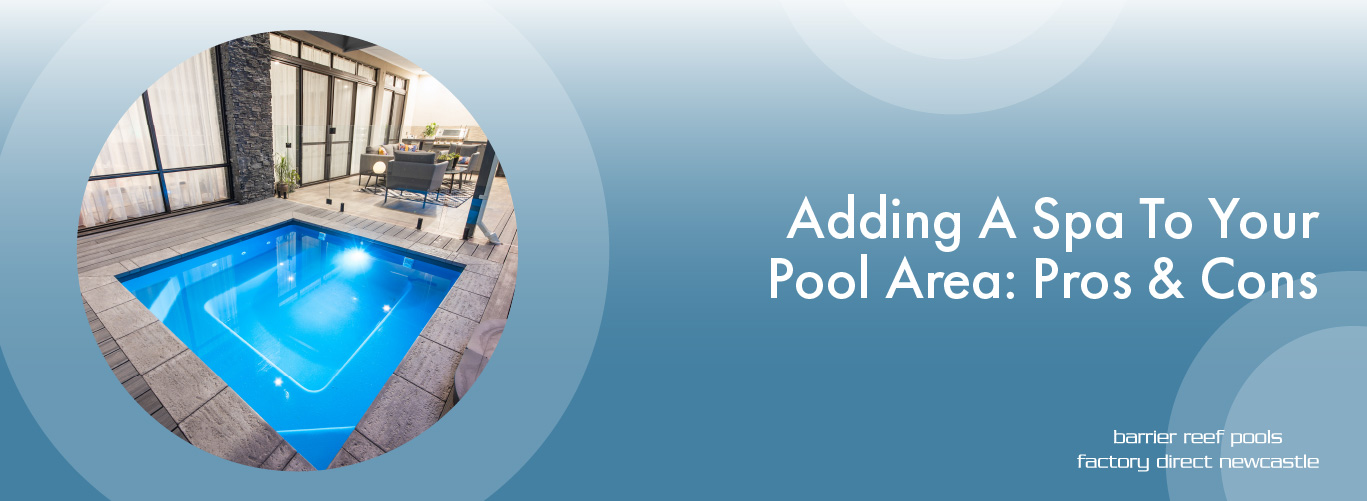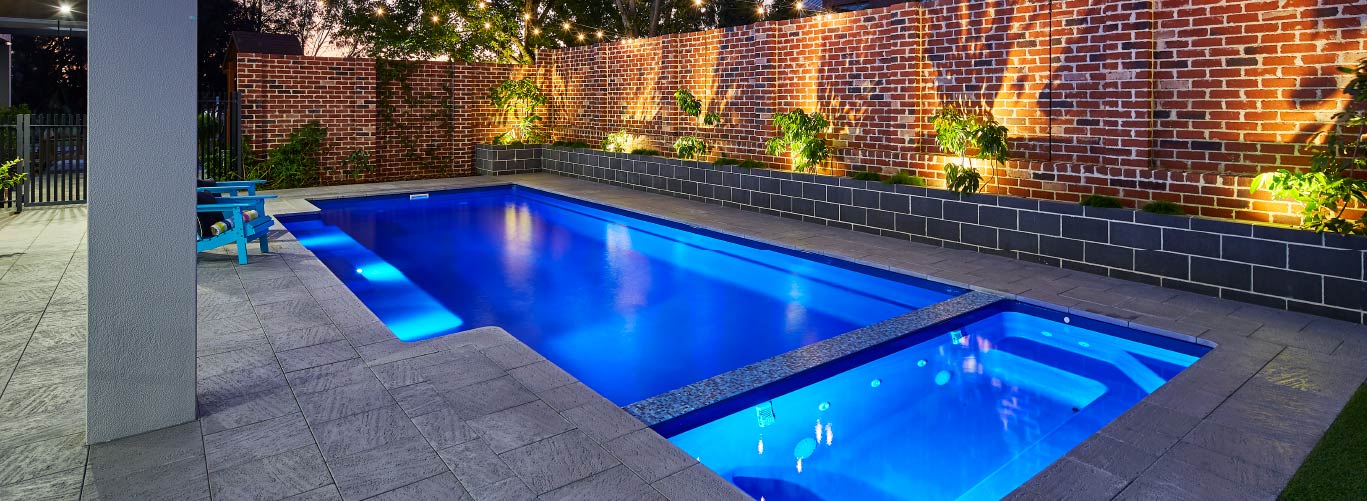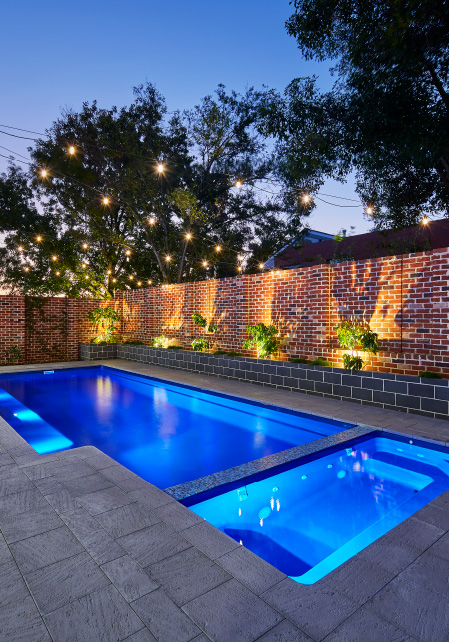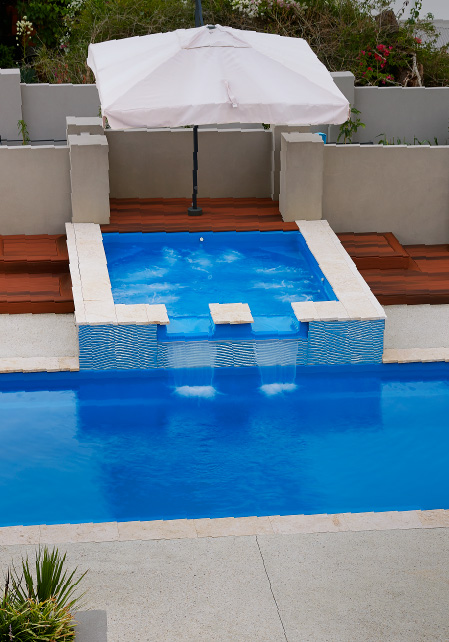Adding A Spa To Your Pool Area: Pros & Cons
For homeowners and pool enthusiasts alike, the allure of a serene spa seamlessly integrated with a pool area is becoming increasingly hard to resist. Whether it's the promise of ultimate relaxation or the appeal of boosting home value, the trend of adding a spa to pool areas is on the rise. In this blog post, we will delve into the pros and cons of enhancing your pool area with a spa. By the end, you'll have a clearer picture to help you decide whether this luxurious addition is the perfect fit for your home.

Pros of Adding a Spa to Your Pool Area
Relaxation and Stress Relief Benefits
One of the most compelling reasons to add a spa to your pool area is the unrivalled relaxation it offers. Imagine ending a long day with a soothing soak in warm, bubbling water. The combination of heat, buoyancy, and massage jets can significantly reduce stress, ease muscle tension, and promote a sense of well-being. This serene experience can be a daily retreat right in your backyard.
Enhanced Social Experiences with Friends and Family
A spa transforms your pool area into the ultimate social hub. Whether you’re hosting a summer barbecue or a quiet evening gathering, a spa provides a relaxing environment for conversation and enjoyment. It’s an ideal spot for friends and family to come together, fostering deeper connections and creating memorable experiences.
Potential Health Benefits of Hydrotherapy
Hydrotherapy has been lauded for its numerous health benefits, including improved circulation, reduced inflammation, and relief from arthritis and chronic pain. Regular use of a spa can contribute to better sleep, enhanced mobility, and overall physical and mental well-being. For those with specific health conditions, a spa can be a therapeutic tool in their wellness routine.
Increase in Property Value and Attractiveness for Future Buyers
From a financial perspective, adding a spa can increase the appeal and value of your property. Potential buyers often view a spa as a luxurious and desirable feature, especially in upmarket neighbourhoods. This investment can potentially yield a higher resale value, making your home stand out in a competitive real estate market.

Cons of Adding a Spa to Your Pool Area
Initial High Costs of Installation
While the benefits are numerous, the initial cost of installing a spa can be quite high. Expenses include the spa unit itself, excavation, plumbing, electrical work, and potentially landscaping to integrate it into your existing pool area. These costs can quickly add up, so it’s crucial to have a clear budget and plan.
Additional Maintenance Requirements and Operational Costs
A spa requires regular maintenance to keep it in top condition. This includes balancing chemicals, cleaning filters, and routine inspections to ensure all components are functioning correctly. Additionally, operational costs such as heating and electricity can be significant, particularly during colder months when the spa is used more frequently.
Limited Space and Design Challenges for Some Pool Areas
Not every backyard is perfectly suited for a spa. Limited space can pose significant design challenges, requiring creative solutions to integrate a spa without compromising the aesthetics or functionality of your pool area. Additionally, ensuring that the spa complements the existing landscape and pool design can be a complex task.
Consideration of Safety Concerns and Regulatory Requirements
Safety is paramount when adding a spa. This includes ensuring proper installation, adhering to local building codes, and implementing safety features such as non-slip surfaces and secure covers. Regulatory requirements may also dictate certain aspects of spa installation, adding another layer of complexity to the project.
Planning and Design Considerations
Tips for Integrating a Spa Seamlessly into Your Pool Area
To achieve a harmonious integration, consider the overall layout and flow of your pool area. Think about the visual and functional relationship between the spa and the pool, ensuring easy access and a cohesive design. Consulting with a landscape architect or pool designer can provide valuable insights and innovative solutions.
Factors to Consider in Spa Size, Shape, and Location
Selecting the right size and shape for your spa is vital. It should comfortably accommodate your intended number of users without overwhelming your pool area. Location is equally important – choose a spot that offers privacy, shelter from the wind, and easy access to utilities. Consider the view from the spa as well, aiming for a pleasant and relaxing outlook.
Insights on Selecting the Right Heating, Filtration, and Control Systems
Modern spas come with a variety of heating, filtration, and control options. Opt for an energy-efficient heating system to keep operational costs manageable. Advanced filtration systems ensure clean and safe water, while intuitive control systems allow for easy operation and maintenance. Researching and selecting the best technology for your needs will enhance your overall spa experience.

Maintenance and Operational Insights
Overview of Regular Maintenance Needs and Cost Estimates
Regular maintenance is essential to keep your spa in optimal condition. Weekly tasks include checking and balancing water chemicals, cleaning the filter, and inspecting the spa cover. Monthly and annual maintenance may involve deeper cleaning, professional inspections, and equipment servicing. Budgeting for these ongoing costs is crucial to avoid any surprises.
Efficient Operational Practices to Reduce Energy and Water Usage
To minimise energy and water consumption, consider using a thermal blanket to retain heat when the spa is not in use. Lower the thermostat when the spa is not needed and invest in an energy-efficient pump and heater. Regularly checking for leaks and ensuring the spa cover is in good condition will also contribute to more efficient operation.
Advice on Selecting Reliable Service Providers for Maintenance and Repairs
Choosing a reputable service provider for your spa maintenance and repairs is essential for longevity and performance. Look for providers with positive reviews, industry certifications, and transparent pricing. Building a good relationship with a reliable service provider ensures your spa remains a source of relaxation and enjoyment for years to come.
Conclusion
Adding a spa to your pool area offers a blend of luxury, relaxation, and potential health benefits, making it an attractive addition for many homeowners. However, it’s important to weigh these advantages against the initial cost, ongoing maintenance, and potential design challenges. Careful planning, informed decisions, and professional advice are key to making the most of this investment. Whether you’re looking to enhance your personal retreat or increase your property value, a spa can be a wonderful addition to your outdoor living space.
Adding A Spa To Your Pool Area: Pros & Cons
For homeowners and pool enthusiasts alike, the allure of a serene spa seamlessly integrated with a pool area is becoming increasingly hard to resist. Whether it's the promise of ultimate relaxation or the appeal of boosting home value, the trend of adding a spa to pool areas is on the rise. In this blog post, we will delve into the pros and cons of enhancing your pool area with a spa. By the end, you'll have a clearer picture to help you decide whether this luxurious addition is the perfect fit for your home.

Pros of Adding a Spa to Your Pool Area
Relaxation and Stress Relief Benefits
One of the most compelling reasons to add a spa to your pool area is the unrivalled relaxation it offers. Imagine ending a long day with a soothing soak in warm, bubbling water. The combination of heat, buoyancy, and massage jets can significantly reduce stress, ease muscle tension, and promote a sense of well-being. This serene experience can be a daily retreat right in your backyard.
Enhanced Social Experiences with Friends and Family
A spa transforms your pool area into the ultimate social hub. Whether you’re hosting a summer barbecue or a quiet evening gathering, a spa provides a relaxing environment for conversation and enjoyment. It’s an ideal spot for friends and family to come together, fostering deeper connections and creating memorable experiences.
Potential Health Benefits of Hydrotherapy
Hydrotherapy has been lauded for its numerous health benefits, including improved circulation, reduced inflammation, and relief from arthritis and chronic pain. Regular use of a spa can contribute to better sleep, enhanced mobility, and overall physical and mental well-being. For those with specific health conditions, a spa can be a therapeutic tool in their wellness routine.
Increase in Property Value and Attractiveness for Future Buyers
From a financial perspective, adding a spa can increase the appeal and value of your property. Potential buyers often view a spa as a luxurious and desirable feature, especially in upmarket neighbourhoods. This investment can potentially yield a higher resale value, making your home stand out in a competitive real estate market.

Cons of Adding a Spa to Your Pool Area
Initial High Costs of Installation
While the benefits are numerous, the initial cost of installing a spa can be quite high. Expenses include the spa unit itself, excavation, plumbing, electrical work, and potentially landscaping to integrate it into your existing pool area. These costs can quickly add up, so it’s crucial to have a clear budget and plan.
Additional Maintenance Requirements and Operational Costs
A spa requires regular maintenance to keep it in top condition. This includes balancing chemicals, cleaning filters, and routine inspections to ensure all components are functioning correctly. Additionally, operational costs such as heating and electricity can be significant, particularly during colder months when the spa is used more frequently.
Limited Space and Design Challenges for Some Pool Areas
Not every backyard is perfectly suited for a spa. Limited space can pose significant design challenges, requiring creative solutions to integrate a spa without compromising the aesthetics or functionality of your pool area. Additionally, ensuring that the spa complements the existing landscape and pool design can be a complex task.
Consideration of Safety Concerns and Regulatory Requirements
Safety is paramount when adding a spa. This includes ensuring proper installation, adhering to local building codes, and implementing safety features such as non-slip surfaces and secure covers. Regulatory requirements may also dictate certain aspects of spa installation, adding another layer of complexity to the project.
Planning and Design Considerations
Tips for Integrating a Spa Seamlessly into Your Pool Area
To achieve a harmonious integration, consider the overall layout and flow of your pool area. Think about the visual and functional relationship between the spa and the pool, ensuring easy access and a cohesive design. Consulting with a landscape architect or pool designer can provide valuable insights and innovative solutions.
Factors to Consider in Spa Size, Shape, and Location
Selecting the right size and shape for your spa is vital. It should comfortably accommodate your intended number of users without overwhelming your pool area. Location is equally important – choose a spot that offers privacy, shelter from the wind, and easy access to utilities. Consider the view from the spa as well, aiming for a pleasant and relaxing outlook.
Insights on Selecting the Right Heating, Filtration, and Control Systems
Modern spas come with a variety of heating, filtration, and control options. Opt for an energy-efficient heating system to keep operational costs manageable. Advanced filtration systems ensure clean and safe water, while intuitive control systems allow for easy operation and maintenance. Researching and selecting the best technology for your needs will enhance your overall spa experience.

Maintenance and Operational Insights
Overview of Regular Maintenance Needs and Cost Estimates
Regular maintenance is essential to keep your spa in optimal condition. Weekly tasks include checking and balancing water chemicals, cleaning the filter, and inspecting the spa cover. Monthly and annual maintenance may involve deeper cleaning, professional inspections, and equipment servicing. Budgeting for these ongoing costs is crucial to avoid any surprises.
Efficient Operational Practices to Reduce Energy and Water Usage
To minimise energy and water consumption, consider using a thermal blanket to retain heat when the spa is not in use. Lower the thermostat when the spa is not needed and invest in an energy-efficient pump and heater. Regularly checking for leaks and ensuring the spa cover is in good condition will also contribute to more efficient operation.
Advice on Selecting Reliable Service Providers for Maintenance and Repairs
Choosing a reputable service provider for your spa maintenance and repairs is essential for longevity and performance. Look for providers with positive reviews, industry certifications, and transparent pricing. Building a good relationship with a reliable service provider ensures your spa remains a source of relaxation and enjoyment for years to come.
Conclusion
Adding a spa to your pool area offers a blend of luxury, relaxation, and potential health benefits, making it an attractive addition for many homeowners. However, it’s important to weigh these advantages against the initial cost, ongoing maintenance, and potential design challenges. Careful planning, informed decisions, and professional advice are key to making the most of this investment. Whether you’re looking to enhance your personal retreat or increase your property value, a spa can be a wonderful addition to your outdoor living space.


